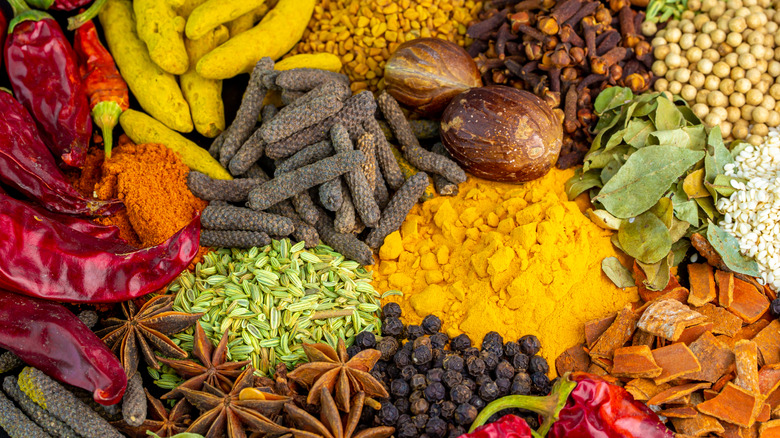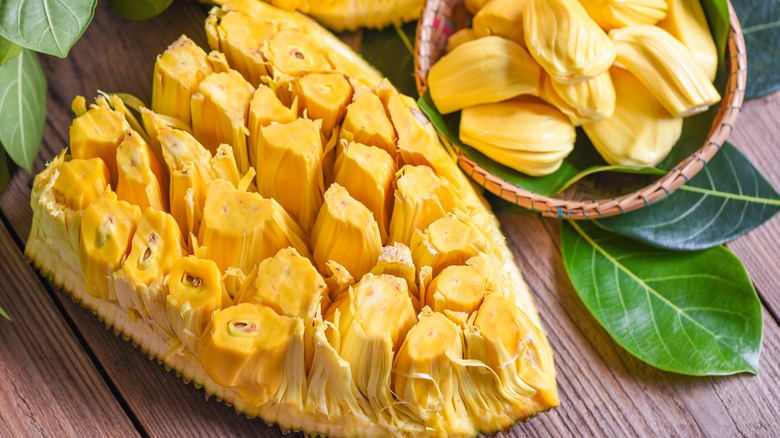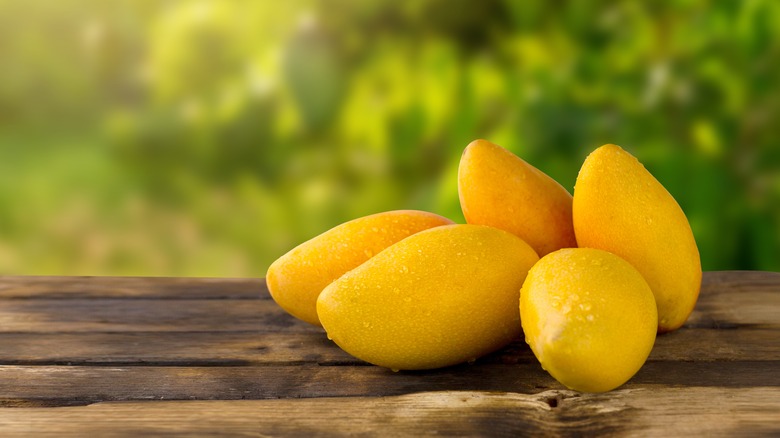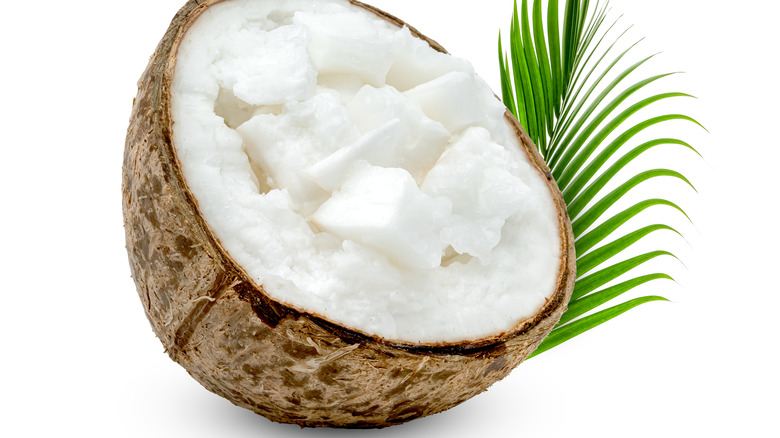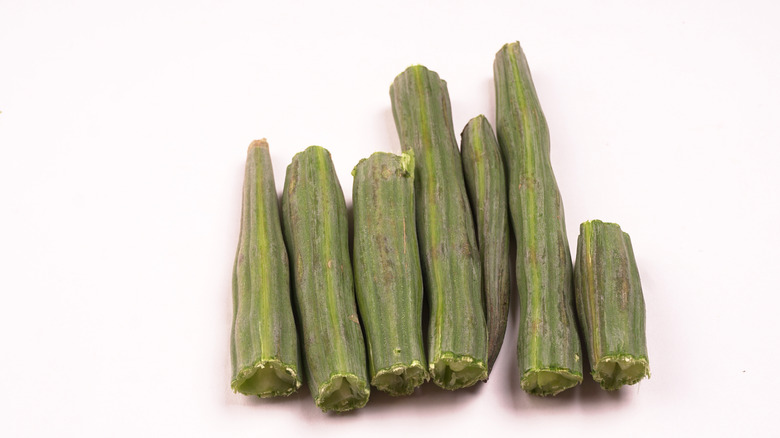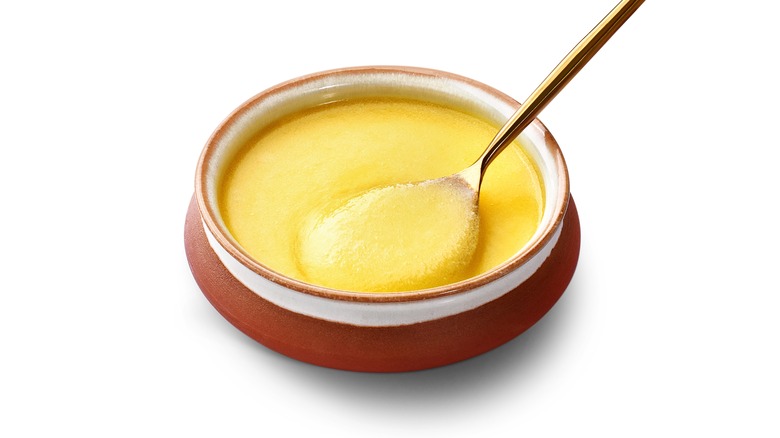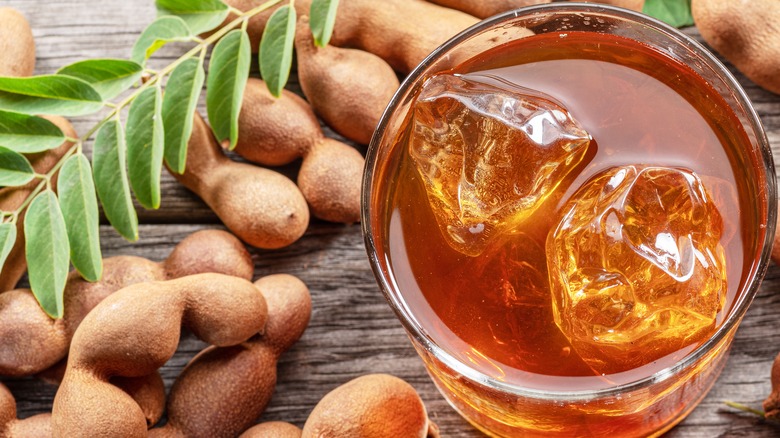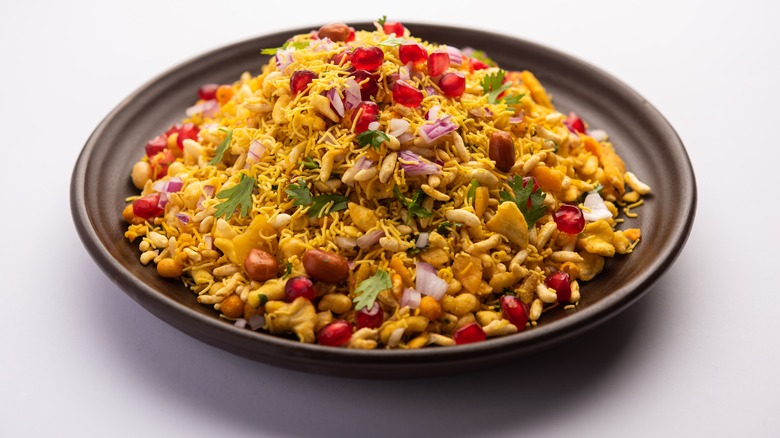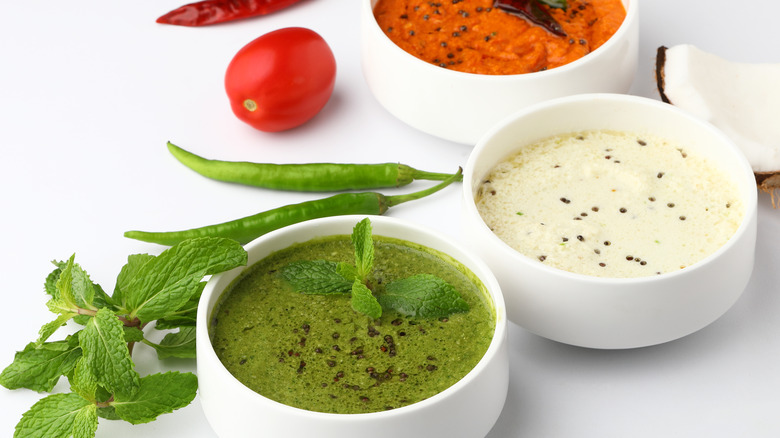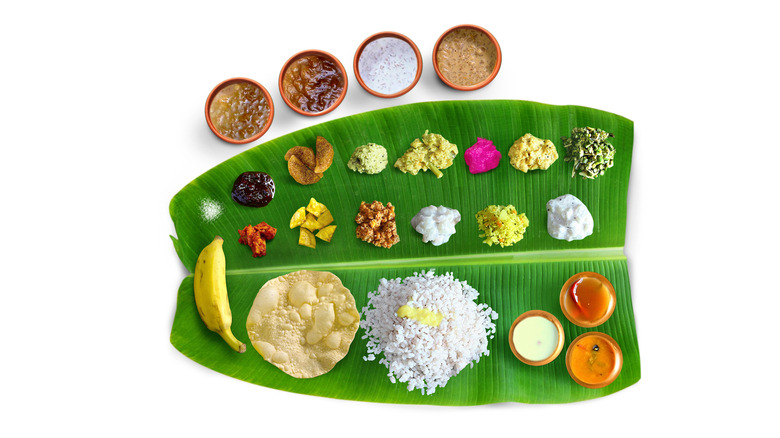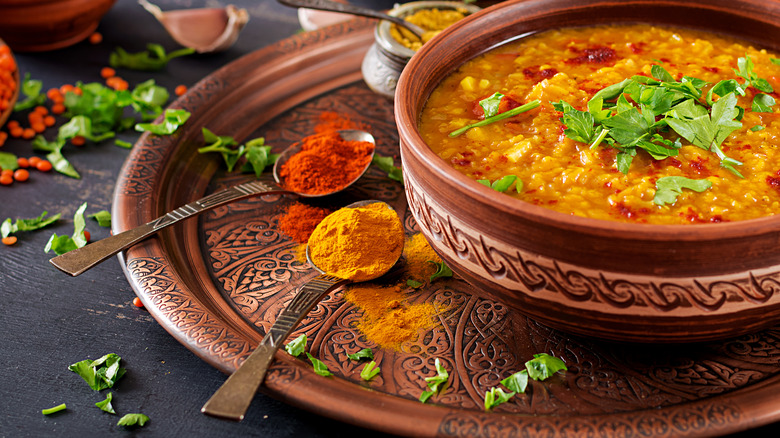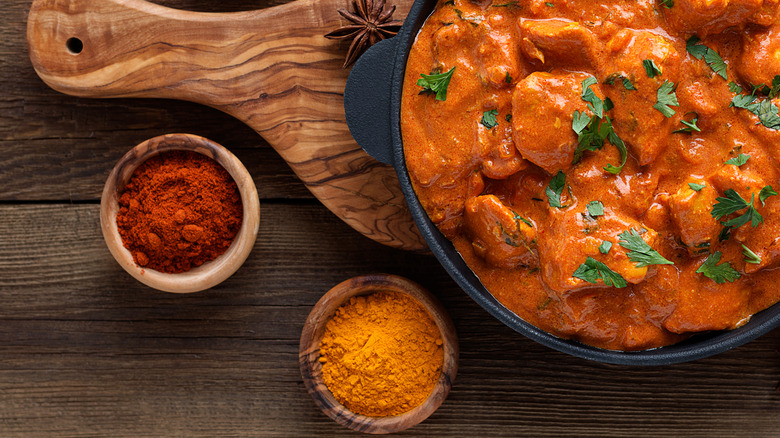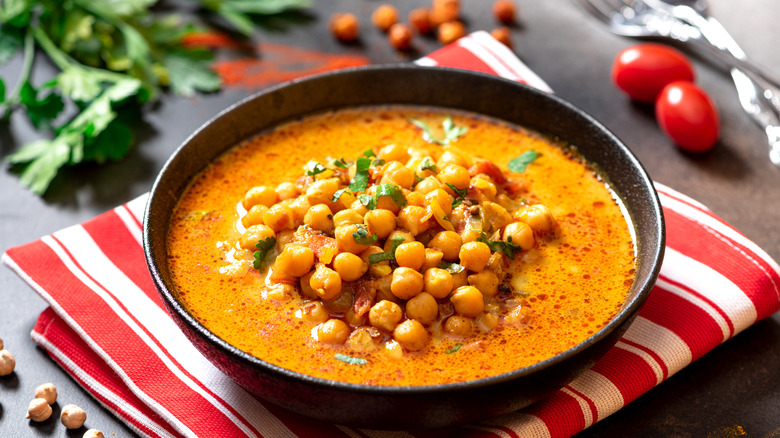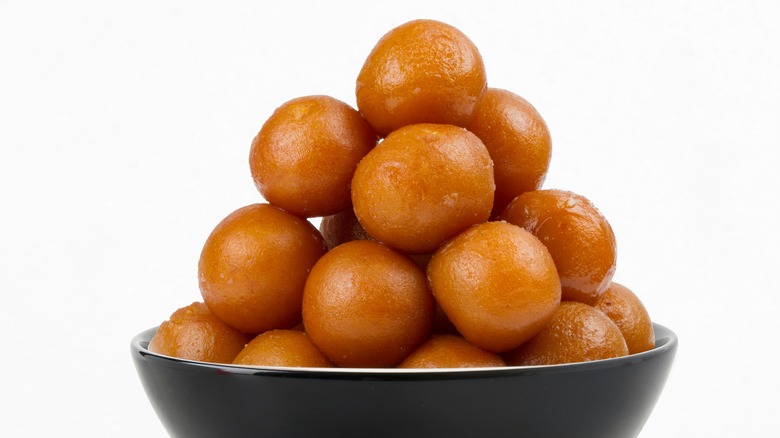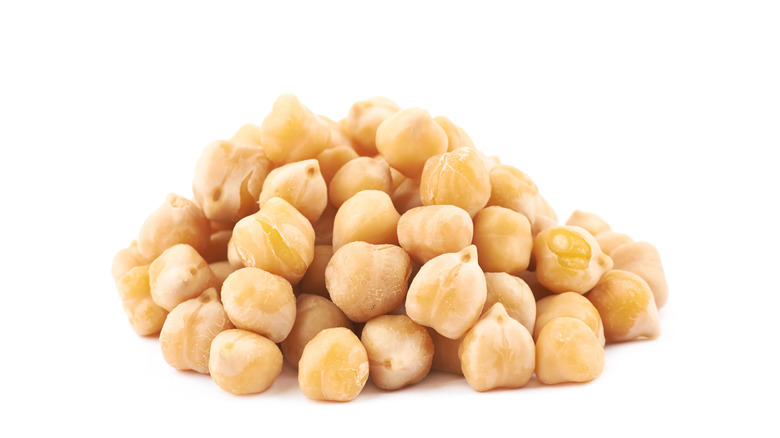14 Canned Foods To Look Out For In Indian Grocery Stores
We may receive a commission on purchases made from links.
Are you looking to cook up a healthy meal in a pinch? Perhaps your trying your best to avoid ordering out, or maybe just in the mood for a meal loaded with contrasting flavors and textures. If so, then cook up delicious, spice-forward Indian dishes on the fly with pantry-ready canned goods.
Canned food is convenient, affordable, and nutritious: Studies show that foods maintain their nutrient levels after being canned (via Healthline). The extended shelf life means you can keep your pantry stocked with healthy canned goods that will make it easier to create a last-minute meal. Indian grocery stores carry countless of canned goods, many of which are the basis for classic Indian dishes. Bonus: Canned foods are also super affordable. But, even if you don't live near an Indian grocery store, you can easily find most of these inexpensive canned goods online.
Here are our favorite canned foods, plus a few jarred delights with a long shelf life — all of which you can find in an Indian grocery store — so you can bring the decadent flavors of India into your home kitchen and cook up your favorite dishes in a snap.
Jackfruit
Naturally sweet, jackfruit is a tropical fruit with pebble-like skin and yellowish, stringy flesh that is native to South India. When it's perfectly ripe, jackfruit boasts notes of pineapple and banana, while young green jackfruit is less sweet, with a texture that many compare to cooked, shredded chicken. The largest tree fruit in the world, jackfruit is packed with nutrition, including immune-boosting vitamins A and C (via Healthline).
When it comes to cooking, jackfruit is a multi-purpose fruit. Its fibrous texture and ability to take on savory flavors make it an ideal vegan-approved fill-in for shredded meat: a pulled jackfruit taco recipe gives the meat-filled versions a run for the money. On the sweeter side, jackfruit delivers a unique multi-fruit flavor to puddings, ice creams, and cakes. Chef Maneet Chauhan even used jackfruit to whip up a new take on an American classic: jackfruit upside-down cake.
Jackfruit is commonly used in South and Southeast Asian cuisines but can be challenging to find at your local grocer. Thankfully, it's also canned, and you can easily find it at your favorite Indian grocer or on Amazon.
Pureed mango pulp
Mango is a stone fruit that has been cultivated in South and Southeast Asia since ancient times. Beloved for their sweet and every-so-slightly spicy flavor, Mangos are low in calories but high in nutrients: 1 cup (165 grams) of fresh mango provides nearly 67% of your daily recommended vitamin C.
Finding perfectly ripe mangos at your local grocer can be hit or miss, and mangos are notoriously prone to spoilage. Thankfully, canned mango pulp, widely available at Indian grocery stores, is made with mangos preserved at peak freshness and is ready to serve as soon as you open the can. Canned mango pulp can substitute for fresh mango in most recipes. Mango pulp also adds a tropical flavor punch to boozy beverages and smoothies: Use it to whip up boozy mango and kefir lime lassis or mango banana smoothies. Pureed mango is also a sweet addition to hot sauce.
Coconut cream
Coconut cream is made from blended, fresh coconuts. The canned cream has a higher fat content than coconut milk, making it a vegan substitute for recipes that call for cream made from dairy. Considered a staple in several Southeast Asian countries, you can easily find coconut cream in the canned goods section of your local grocer. Dairy-free and unsweetened, with a touch of coconut flavor, coconut cream works incredibly well as a creamy, decadent (keto-friendly!) addition to curries and soups.
Coconut cream can also readily replicate dairy in countless types of baked goods. Keep canned coconut cream stocked in your pantry so you can whip up last-minute desserts like coconut crepe cake recipe, a coconut custard pie recipe, or some golden milk vegan ice cream. Hot summer days might call for a cool and refreshing piña colada in the comfort of your own home kitchen thanks to canned pineapple and cream of coconut, plus a little rum and ice.
Drumsticks in brine
Though they're largely unknown outside of India, drumsticks are long, green seed pods from the moringa oleifera tree, often used as an addition to vegetable-based soups or served cooked with tomatoes and onions and paired with yogurt sauce. Folk medicine practitioners have touted the many benefits of moringa, a.k.a. the "miracle tree" for centuries. The tree is among the fastest growing trees on planet Earth: It can grow a whopping 10 to 15 feet within a year of being planted! The moringa has four edible parts: leaves, seeds, roots, and pods, also known as drumsticks.
In India, Saragawa drumsticks can easily be found fresh at local markets; here in the U.S., you can find drumsticks canned in brine at your local Indian grocer. Fresh moringa drumsticks need to be boiled before consumption, but canned drumsticks are ready-to-eat. These long bean pods are tough on the outside but soft and fleshy on the inside, similar to okra, and can even be used as a substitute for okra in soups and stew.
Ghee
Ghee, or clarified butter, is a staple in many Indian kitchens and can be used in a 1:1 ratio with butter. The difference between ghee and butter is simple: Ghee doesn't contain milk solids and any water is removed during the cooking process, so it's essentially 100% pure butterfat. Ghee is made by simmering butter over a stovetop and then clarifying it, or separating the milk solids and water over low heat.
Because it is dairy-free, ghee has a higher smoking point than regular butter — it can be heated to about 450 degrees — so it's great for stir-frying, sautéing, deep-frying, and searing. It even tastes great drizzled over popcorn! Ghee's versatility goes beyond the kitchen: In India, ghee is an essential element of Ayurvedic medicine and is also used as a skin and hair moisturizing agent. It's often available in a glass jar and can be stored in your pantry.
Tamarind paste
While Tamarind is made from the fruit of a tree indigenous to Equatorial Africa, Tamarind paste is today a staple of Indian, Thai, and Mexican cooking. The fruit of the tamarind tree looks like a peanut pod, but instead of revealing a nut, its interior is filled with a sour pulp that sweetens as the fruit ripens. Tamarind pulp, a.k.a. nature's sour candy, is sour since it's high in tartaric acid, but it becomes progressively sweeter as it matures. Its sour, sweet and tangy flavor makes it a popular addition to chutneys, curries, sauces, stir-fries, and noodle dishes.
Keep tamarind past on hand and use to make tangy tamarind barbeque sauce recipe, Indian nachos, or a spiced okra sambar stew recipe, a South Indian staple with a lentil and okra base with a tangy tamarind finish. Tamarind has been finding its way into cocktails across the country and offers a tart twist on the classic whisky sour.
Bhel puri concentrate
India is known for its street food, with carts serving up on-the-go delights across the country. Bhel puri, a crunchy salad with sweet and sour elements, is one of India's most beloved and irresistible street snacks. Though the recipe likely originated in Mumbai, you can find Bhel puri on street carts across India today. It's easy to make at home, too, with ingredients that can be found at your local Indian grocer: Simply mix puffed rice with sev (crunchy, vermicelli noodles made from besan flour), add chopped onions, tomatoes, fresh cilantro, and cooked potatoes, then stir in bhel puri concentrate, a sweet, tart chutney that's available in glass jars.
Every chef seems to have a different take on bhel puri toppings, with some chefs garnishing the dish with raw sweet mango and others with diced onions; some chefs add chopped green chilies for a mouth-tingling take. Bhel puri concentrate is rich in flavor thanks to tamarind, dates, mint leaves, coriander leaves, green chili, and spices, including cumin, black pepper, crushed red pepper, fennel, and dried mango.
Chutney
Originating in India, chutney is a tangy, tart, preserve-like condiment made with chopped fruits, vinegar, sugar, and spices such as ginger, cinnamon, cloves, coriander, nutmeg, allspice, and cardamom. Chutney is similar to a relish, but instead of vegetables, chutneys usually contain fruit.
While you can always make your chutney at home — such as our preserved lemon chutney recipe — local Indian grocers usually carry a wide range of super spicy to sweet chutneys made with different fruit flavors, including mango, tamarind, apricot, and peach. You can also find chutneys made with unique, fruity flavors like coconut, pumpkin, quince, plums, or even carrot.
Chutney was made to complement curry and is traditionally paired with spicier foods to help take some of the heat out of the dish. This topping also complements strong-flavored meats and even cheese: Simply spoon some from the jar and use like you would a relish. It also makes for an excellent dipping sauce for spicy Indian appetizers like samosas and vegetable pakoras.
Curry paste
Curry paste is the key to crafting delicious, vibrant curries in a pinch at home. Curry paste is typically made with the same staple Indian spices you'll find in curry powder blends — turmeric, coriander, chili powder, and cumin — but the addition of oil, garlic, and chilies for its powerful punch of flavor. You'll usually find three types of curry paste at your local Indian grocery: Red curry paste is typically the spiciest; green curry paste is mild with herbaceous notes; yellow curry paste is warming, mild, and slightly sweet.
Unsurprisingly, paste is commonly used to up the flavor ante in the base of a curry dish, but it also works well as a marinade or as a rub for chicken, fish, or beef. Add to any soup or stew at the beginning of the cooking process. Mix curry paste with yogurt for a dipping sauce or with vinegar for an Indian-inspired salad dressing. Store your curry paste in the pantry, and upon opening the jar, keep it stored in the fridge.
Pickle relishes
Pickle relishes are a popular condiment in Indian cuisine. Many families prepare their own pickle relishes in the summertime, with recipes passed down from generations, but you can also find pickle relishes in glass jars stateside at your local Indian grocery store. So many classic Indian dishes like daal, Masala dosa, and vegetable pulao would be lost with a pickle relish on the side, an essential element that packs additional flavor.
Thali, a traditional communal-style Indian meal made up of a selection of about 10 dishes served on a platter, always includes a pickle relish or two. There are hundreds of varieties of pickle relishes in India, and each state boasts its own classic recipes. Some relishes are extra sour, some extra sweet, and some extra spicy, so you can easily pair a pickle with your taste buds. Mango, lemon, chili, carrot, cabbage, cauliflower, onion, potato, garlic, gooseberries, tomato, and bitter gourd pickles are usually available at Indian grocery stores in the U.S.
Jyoti Natural Foods
Aromatic, rich, creamy, and buttery — Makhani means "with butter" in Urdu — dal makhani is a classic Punjabi dish. Preparing Makhani sauce at home, however, requires hours, as you'll also need to soak the black lentils and red beans and simmer for hours. Jyoti Natural Foods was founded in Pennsylvania in 1979 by Jyoti Gupta, who wanted to introduce homestyle Indian cuisine to the U.S. Today, the company produces and markets a wide range of homestyle Indian dishes that can be prepared by simply opening a can, heating, and serving.
For a protein-rich, vegetarian main dish in seconds, a can of Jyoti Natural Foods' Dal Makhani, made of spiced black lentils and red beans is easy enough to heat and serve over basmati rice (especially when using tips for making basmati rice fluffier) or with naan, the classic Indian flatbread. You can also give a recipe for naan with nigella seeds and cilantro a try!
Jyoti also makes canned Matar Paneer, a potato-and-pea curry, and Dehli-style saag, a spinach curry, two classic Indian dishes that also take hours to prepare from scratch and are best served with basmati or naan.
Ready-to-simmer sauces
Indian home chefs in the know keep ready-to-simmer sauces in the pantry for whipping up curries in a pinch. Rich and flavorful, ready-to-simmer sauces are fully-cooked, flavorful options that make it possible to cook up a curry dish in mere minutes instead of hours. You'll usually find two types of ready-to-simmer sauces at your local Indian grocery store: Tikka Masala and Punjabi Masala.
Tikka Masala balances tart tomatoes with cumin and coriander. Punjabi Masala is also tomato-based but with a ginger and tamarind kick. Founder Anupy Singla, author of three cookbooks, is said to have used this recipe from her mother who made the base for fast meals during the weeks before her wedding.
For a classic Indian meal in minutes, simply sear your choice of meats or vegetables, pour in your sauce, and simmer until heated. Serve your dish with an Indian flatbread like roti or naan or with basmati rice.
Kitchens of India ready-to-eat meals
From pantry to plate, it's never been easier to whip up an Indian meal in mere minutes thanks to Kitchens of India, a company known across the globe for its ready-to-eat meal pouches. Featuring a wide range of dishes from across the Indian sub-continent, Kitchens of India packs classic dishes into shelf-stable pouches that stay fresh in your pantry for over a year. Fortunately, these pre-made meal kits are easily found at Indian grocers stateside.
The many dishes available in pouch form include black lentil curry, sag paneer (spinach with cottage cheese), rajma masala (red kidney bean curry), navratan korma (mixed vegetable and cottage cheese curry), pav bhaji (mashed vegetable curry), and pindi chana (chickpea curry). Simply microwave for 1-2 minutes or boil for 3-4 minutes and you'll have a delicious, authentic Indian meal ready to go. Bonus: Kitchens of India is a sustainable company, and has been carbon, water, and solid-waste recycling positive for over a decade.
Gulab Jamun
Looking for a last-minute desert to complement an Indian meal? Gulab Jamun is a dessert made of golden, fried, pillowy doughnut balls soaked in a rose-scented syrup. This is a classic Indian dessert that you can serve straight out of a can! Though Gulab Jamun likely originates from medieval Persia, the dessert is served at most Indian celebrations such as weddings, Muslim celebrations of Eid ul-Fitr and Eid al-Adha, and the Hindu festivals of Diwali.
Gulab Jamun is a time-consuming dessert to prepare from scratch since it's made by heating milk over a low flame and simmering until the water evaporates and only the milk solids remain, a process that can take up to two hours. The milk solids are then folded into flour and formed into balls, which are then soaked in a fragrant syrup. Gulab Jamun in a can be served in seconds, straight from the can at room temperature, or heated for thirty seconds in the microwave and served warm.
Canned legumes
From lentils to chickpeas to kidney beans, beans are featured in so many plant-powered Indian dishes. Smart home chefs stock up on cases of canned beans at local Indian grocery stores. Why? Canned beans not only make is easy to pull together a healthy dinner in a pinch, but they're also affordable and can be stored long-term in your pantry, so you're less likely to rely on carry-out when your craving Indian cuisine. Dried beans require hours of soaking and simmering, and so can't be used to whip up a last-minute meal.
Just like dried beans, canned beans are packed with plant-powered protein and nutrients such as iron and folate (via Healthline). But note that one can of canned beans can contain up to 570 mg of salt, 25% of the recommended daily intake, so if you're watching your sodium intake, you're better off with dried beans.
